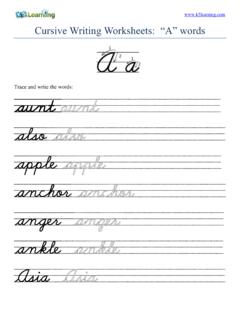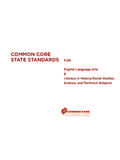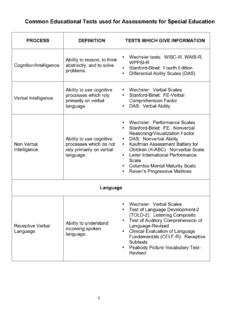Transcription of Handwriting Intervention Strategies - MCESC
1 1 Handwriting Intervention Strategies Occupational and Physical Therapy Department Montgomery County ESC Regional Center January 2009 Information adapted from: Classroom Remedial Strategies for Handwriting Difficulties Copyright: Maxanna Learning Systems Handwriting : Under Construction 2 Problem: The student has difficulty with spatial organization when writing . Children who struggle with spatial ordering have decreased awareness regarding the spatial arrangement of letters, words or sentences on a page. In writing it looks like poor use of lines on paper, organizational problems, uneven spacing between letters, poor awareness of margins and many misspelled words. Recommendations: When students are copying from a worksheet or blackboard, insert markers that act as a signal to check spacing.
2 A stop sign, red circle, or dash could be used (Include* spaces* between* your* words) or (When you see* the asterisk* pause to check* your spacing). Over-emphasize spaces between words (Make the spaces large enough so that they can t go unnoticed). Have the student read the words out loud when writing and say the word space when there is a space. If the student has trouble staying within the lines of the paper, try different kinds of paper or modify current paper (a variety of paper can be found in many specialty catalogs such as Abilitations, Southpaw Enterprises, and Achievement Products at , etc.). Hi-Write paper: The entire area between the bottom and middle line on 3-lined paper is highlighted as a visual cue for placement of letters.
3 Raised line paper Consider width of writing area: Some students will have greater success with intermediate versus primary paper based on development of hand skills. It is often easier to produce smaller movements when writing than larger movements. Consider highlighting lines or using single/double/triple lined paper. RediSpace paper: Provides green and red margins and a designated space for each letter. If the student has trouble starting on the left side of the paper, place a piece of green tape along the left side of the desk and a piece of red tape along the right side of the design to signal GO and STOP. Similarly, marker lines on the left and right side of each paper can be used. Use a physical spacer such as a Popsicle stick, finger, eraser, or small post-it note.
4 Use large-square graph paper to help students visualize spacing of words and letters. Use graph paper or turn lined paper horizontally to create columns to help keep math problems aligned. Use a checklist for self-editing. Additional Recommendations: 3 Problem: The student writes too slowly to keep up with the class. When students are unable to keep up with the rest of the class, they may not have learned the letter patterns adequately. Speed should not be addressed until letter formations have been learned. Also consider other underlying areas of concern such as issues with attention, memory, language, graphomotor (movement associated with writing ), and cognition. Recommendations: If letters have not been learned adequately, provide further instruction and daily practice.
5 Mad Minutes: Have students write within a short timed period (one, two, or three minutes). Record the number of letters written legibly per minute. Try having the students copy or free write the lowercase or uppercase alphabet, words or sentences. Chart the results. Reduce the writing load. Have another student share his notes. Provide copies of important information. Provide keyboarding instructions or use an assistive device such as an Alphasmart. Consider cursive writing versus printing. Consider the writing instrument: mechanical pencil, pen, standard pencil, marker, crayon, etc. Other recommendations: Provide seat cushion for task attention. Use of a slant board to increase visual attention and improve hand positioning. Placement of desk/chair in the classroom as related to teacher or board.
6 Provide a pencil grip. Increase the length of time given to complete assignments. Additional Recommendations: 4 Problem: The student has difficulty copying from the board. Recommendations: Rule out visual problems. Does the student have glasses or acuity issues? Is the student able to visual attend and track? Have students face the board when writing . Keep an open desk close to the blackboard for students who have difficulty copying from the board. Limit the amount of copying from the board. Make desktop copies of board work for students. Have the student re-write the information at near point or eliminate the need to copy. Keep the chalkboard uncluttered. Have the student use a slantboard to raise his visual field. Give extra time for the student to copy.
7 Make sure information is written in a legible manner on the board with proper letter closure and size. Have the student use a color overlay, ruler or fingertip to help locate his/her place on the paper when changing vision to look from paper to board and vice versa. Additional Recommendations: 5 Problem: The student has a messy paper. Messy papers can be the result of several things. Often excessive pencil pressure is used which makes writing dark and difficult to erase. The paper may then rip when the student is writing or trying to correct errors. Over-working the letters can also contribute to a messy paper, as can inconsistent slant of letters. Messy papers are often seen with students who have attention issues.
8 Lack of motivation to present neat work may play a factor. Recommendations: Provide a weighted pencil. Place a notebook under the writing paper for sensory feedback. Provide a slant board to raise the visual field and encourage proper hand positioning. Try a variety of writing instruments including mechanical pencils or pens, markers or crayons. Have the student cross out words instead of erasing. Try a pencil grip or triangular pencil aide to change pressure. Provide a model. Try a variety of writing paper which includes extra blank space between lines or have the student skip lines. Breakdown writing to focus on one aspect at a time. Engage in activities that provide deep pressure into the hands prior to writing . These tasks may include chair push-ups or working with putty.
9 Trial different types of erasers including an art eraser. Teach proper erasing mechanics. Is the student stabilizing the paper with his non-dominant hand while erasing with his dominant hand? Use a checklist for self editing. Provide activities to focus on modifying pressure. Use a paintbrush with soft bristles and have the student paint thin lines. Additional Recommendations: 6 Problem: The student does not like to write. Recommendations: Help identify the areas of writing difficulty so that a remediation program can begin. For example, is it difficult to form the letters or come up with the information to be written down? Emphasize quality of Handwriting and not quantity. Reduce the writing load. Comments on the student s paper should emphasize the positive. Motivate the student through incentives, positive reinforcement, and genuine enthusiasm.
10 Try using a Handwriting contract. Compensatory Strategies : Reduce the writing load. Teach keyboarding skills as an alternative to writing . Allow oral reports and examinations. Allow the student to dictate or record assignment. Have another student share his or her class notes. Teacher to provide a copy or outline of class notes: The student can highlight or fill in details to follow the class discussion. Most importantly, stress one or two components of an assignment, but do not expect the student to meet all requirements. For example, on a report, organization and ideas may be the priority while spelling and punctuation are not emphasized. Additional Recommendations: 7 Problem: A student can only write the correct letter formation when a model is present.





